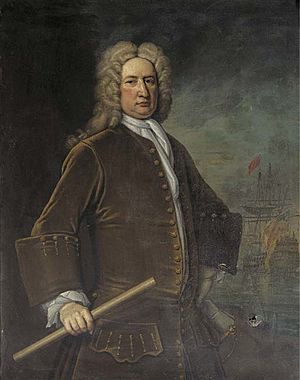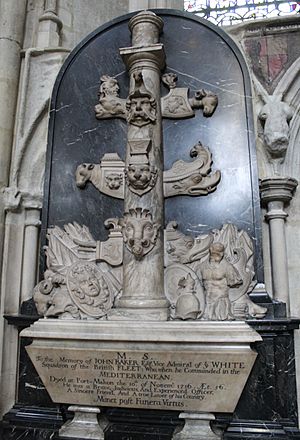John Baker (Royal Navy officer) facts for kids
Quick facts for kids
John Baker
|
|
|---|---|
 |
|
| Born | 1660 |
| Died | 10 November 1716 (aged 55–56) |
| Buried | |
| Allegiance | Great Britain |
| Service/ |
Royal Navy |
| Rank | Vice-Admiral of the Blue |
| Commands held | HMS Mary HMS Boyne HMS Newcastle HMS Falmouth HMS Medway HMS Pembroke HMS Monmouth Mediterranean Fleet |
| Battles/wars | |
John Baker (born 1660 – died 10 November 1716) was a brave officer in the Royal Navy, which is the navy of Great Britain. He became a vice-admiral, a very high rank. He also served as a Member of Parliament, helping to make laws for the country.
Contents
A Life at Sea: John Baker's Story
John Baker began his naval career in 1688 as a lieutenant. This was his first step in becoming a naval officer. By 1691, he was promoted to captain. He commanded several warships during his time at sea.
During the Nine Years' War against France, Baker commanded ships like HMS Mary and HMS Boyne. He spent much of this time sailing in the Mediterranean Sea. Even though he didn't have any huge, famous battles, he gained a lot of experience.
Around 1701, a new big conflict started called the War of the Spanish Succession. Baker was given command of the HMS Monmouth, a powerful 66-gun warship. He stayed on this ship for almost six years.
Fighting in Big Wars
Baker fought in many important battles during the War of the Spanish Succession. He was part of the main fleet led by famous admirals like Sir George Rooke. Some of the major battles he took part in include:
- The Battles of Cadiz and Vigo Bay in 1702.
- The Capture of Gibraltar and the Battle of Málaga in 1704.
- The Siege of Barcelona in 1705.
- The Battle of Toulon in 1707.
These battles were very important for controlling the seas and protecting trade routes.
A Caring Commander
In 1707, Baker's squadron returned to England. Many ships were lost in a terrible storm, known as the Scilly naval disaster. Nearly 2,000 sailors died, including Admiral Sir Cloudesley Shovell.
After this disaster, Baker was told to keep his crew on board for other ships. But he felt this was unfair to his men. He wrote to the Admiralty (the navy's leaders) asking for his crew to be allowed to go home. He said many had been with him for years. This shows he cared deeply about his sailors.
Rising Through the Ranks
John Baker continued to rise in the navy. In 1708, he was promoted to rear-admiral. He helped escort Maria Anna of Austria, a princess, from Holland to Portugal.
By 1709, he became a vice-admiral. He served as the second-in-command in the Mediterranean. He sailed on the HMS Stirling Castle.
Protecting Trade Routes
Towards the end of 1711, Baker was sent to Lisbon and the Azores. His job was to protect important trade ships from pirates and privateers. These were ships that attacked other ships for their cargo.
He successfully drove a Spanish ship ashore and captured a French ship. He made sure the Brazil fleet, which carried valuable goods, arrived safely in Portugal.
After the war ended, Baker returned to England. He was elected as a Member of Parliament for Weymouth. This meant he helped make decisions for the country. He supported the Whigs, a political group at the time.
Soon after King George I became king in 1714, Baker was sent back to the Mediterranean. His mission was to make peace treaties with or stop the corsairs (pirates) of North Africa. He made agreements with Tripoli and Tunis and punished some of the Sallee cruisers.
A Lasting Legacy
John Baker died at Port Mahon on 10 November 1716. He was buried in Westminster Abbey, a very famous church in London. A special monument was built there to remember him.
His epitaph (the words on his monument) described him as "a brave, judicious, and experienced officer, a sincere friend, and a true lover of his country." This shows how much he was respected. His nephew, Hercules Baker, also became a captain in the navy.


